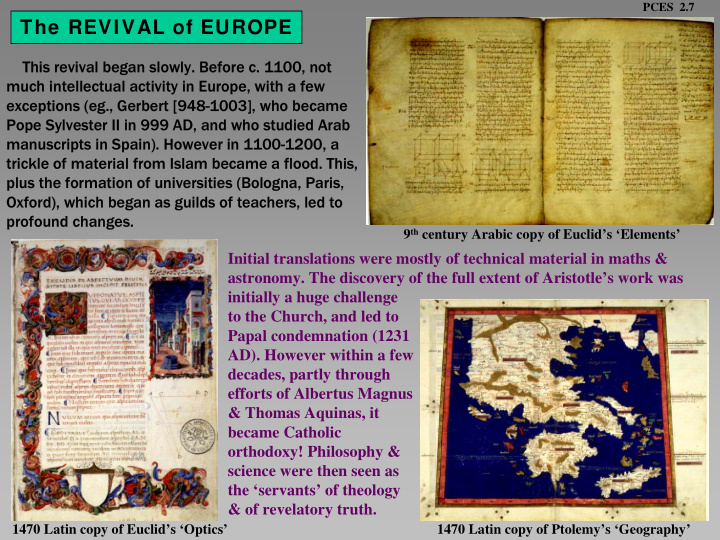



PCES 2.7 The REVIVAL of EUROPE This revival began slowly. Be This revival began slowly . Befo fore c. 1100, not re c. 1100, not much intellectual activity in Europe, with a few much intellectual activity in Europe, with a few exceptions (eg., Gerbert ex ceptions (eg., Gerbert [948-1003], who became 948-1003], who became Pope S Sylv lvester ester II in II in 9 999 AD 99 AD, an , and wh d who studied o studied Ar Arab ab manu ma nuscripts scripts i in Spai Spain). However i n). However in 1100-1200, a 1100-1200, a trickle of material from trickle of material fr om Islam became a flood Islam became a flood. This, . This, plus the formation of univ plus the formation of universities (Bologna, Paris, ersities (Bologna, Paris, Ox Oxford ford), which began as guilds of teachers, led to ), which began as guilds of teachers, led to profound cha profound changes. s. 9 th century Arabic copy of Euclid’s ‘Elements’ Initial translations were mostly of technical material in maths & astronomy. The discovery of the full extent of Aristotle’s work was initially a huge challenge to the Church, and led to Papal condemnation (1231 AD). However within a few decades, partly through efforts of Albertus Magnus & Thomas Aquinas, it became Catholic orthodoxy! Philosophy & science were then seen as the ‘servants’ of theology & of revelatory truth. 1470 Latin copy of Euclid’s ‘Optics’ 1470 Latin copy of Ptolemy’s ‘Geography’
PCES 2.8 Late Mediaeval Science Before the translation of Greek & Islamic works into Latin, science was almost non-existent in the middle ages. The influence of Arab commentators & Arab scientific work (including instruments) on the development of mediaeval science was decisive. Initially the main influence on cosmology (which was essentially viewed as a part of philosophy, along with the general study of Nature) was Platonic, but the discovery of Aristotle’s works caused huge excitement; after the initial clashes Islamic Astrolabe (1309 AD) with the church, the physical understanding of the cosmos & the ‘sub-lunar domain’ became overwhelmingly Aristotelian. In spite of opposition from the church, astrology became almost universally accepted, in the physical and medical sciences, by the 14 th century. Roger Bacon (glass c. 1278 AD) The dichotomy between the physical & mathematical understanding of the world persisted, mediaeval mathematics & astronomy consisting in a discovery and acceptance of the achievements of the Greeks and Arabs. Thus the standard picture of the heavens was based on Ptolemy’s ‘ Almagest ’, & initially the tables used for calculations of celestial motions were translated from Al-Khwarizm & Al-Zarqali (the ‘Toledan tables’); in 1275 the Alfonsine tables were prepared at the court of Alfonsus X of Castile, & used for several centuries thereafter. In the same way the understanding of optics & medicine was a mixture of Greek and Arab ideas, with some notable creative additions by, eg., Roger Bacon (1220-1292), who was in some respects well ahead of his time. The Alfonsine Tables (1275 AD)
PCES 2.9 The ‘Renaissance’ In the 13 th &14th centuries, a complex process of re-emergence began in Mediterranean Europe. influences from the Arab world, and from the slow accumulation of economic change, all had their effect. One of the most important slow changes came about through the development of crop rotation and the invention of metallic farming implements (like ploughs). Other important innovations, many derived from the Arabs, included clear window glass, and various precision instruments Fra Angelico ‘the Annunciation (1431-5) for, eg., time-keeping and navigation. Europe’s population then grew, along with trade. S. Boticelli et al ‘Nastagio degli Honesti, III (1483) ‘Money-Changer & Wife’ (Marinus, 1539)
PCES 2.10 The Classical Aesthetic in Renaissance Italy Bust of Michelangelo by D. da Volterra (1509-66) Above: La Pieta (1498-99) RHS: David (1501-04) The artisitic renaissance is often said to have begun in Firenze (Florence). It was marked by an intense interest in classical (Greek/Roman/etc) ideas, & by new ‘humanist’ ideals (articulated by many, most notably Erasmus in Holland). Those involved included intellectuals, artists and their wealthy patrons, who included powerful princes like Lorenzo de Medici of Florence, and even some popes. The School of Athens, by Raphael (1509)
Recommend
More recommend